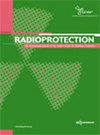COVID-19孕妇的辐射安全:一篇综述文章
IF 1.4
4区 医学
Q4 ENVIRONMENTAL SCIENCES
引用次数: 0
摘要
在冠状病毒COVID-19灾难性爆发期间,对孕妇可能挽救生命的治疗方法不容忽视。肺部感染或肺炎是COVID-19的常见并发症。放射成像在控制疾病和评估冠状病毒COVID-19肺炎后果方面发挥着关键作用。肺部超声(LUS)和胸部计算机断层扫描(CT)是检测和治疗COVID-19最常用的程序,可以预测和预测COVID-19对患者的影响。在这方面,需要深入了解电离辐射的影响及其危害,对孕妇应谨慎使用放射检查。本文旨在探讨COVID-19孕妇在放射检查时的辐射防护问题以及对胎儿的影响。对英文出版物的电子数据库进行了冠状病毒、症状、检测和孕期辐射风险的评估。在这种情况下,需要制定国际规则或标准方案,以协助医生和放射科医生采取必要措施,在怀孕期间检测、控制和随访COVID-19。回顾发现LUS肺部检查是CT的有效替代方法。本文章由计算机程序翻译,如有差异,请以英文原文为准。
Radiation safety for pregnant women with COVID-19: a review article
In the midst of the catastrophic outbreak of coronavirus COVID-19, potentially life-saving treatments for pregnant women cannot be ignored. Pulmonary infection or pneumonia is a common complication of COVID-19. Radiologic imaging plays a critical role in both controlling the disease and evaluating the consequences of coronavirus COVID-19 pneumonia. Lung ultrasound (LUS) and chest-computed tomography (CT) are the most commonly used procedures to detect and treat COVID-19 and can predict and prognosticate the impact on patients of COVID-19. In this context a deep understanding of the effects of ionizing radiation and its hazards is required and radiological examinations should be used cautiously in pregnant women. The aim of this review is to discuss radiation protection issues for pregnant women with COVID-19 during radiological examination with regard to the effects on the fetuses. An evaluation of electronic databases for publications in English was performed for coronavirus, symptoms, detection, and radiation risk in pregnancy. In such circumstances, international rules or standard protocols need to be established to assist physicians and radiologists in the necessary measures for detection, control and follow-up of COVID-19 during pregnancy. The review found that lung examinations with LUS are an effective alternative to CT.
求助全文
通过发布文献求助,成功后即可免费获取论文全文。
去求助
来源期刊

Radioprotection
ENVIRONMENTAL SCIENCES-PUBLIC, ENVIRONMENTAL & OCCUPATIONAL HEALTH
CiteScore
3.30
自引率
54.50%
发文量
35
审稿时长
>12 weeks
期刊介绍:
Radioprotection publishes articles on all aspects of radiological protection, including non-ionising as well as ionising radiations. Fields of interest range from research, development and theory to operational matters, education and training. The very wide spectrum of its topics includes (theoretical and practical aspects): dosimetry, instrument development, specialized measuring techniques, epidemiology, biological effects (in vivo and in vitro) and risk and environmental impact assessments.
 求助内容:
求助内容: 应助结果提醒方式:
应助结果提醒方式:


